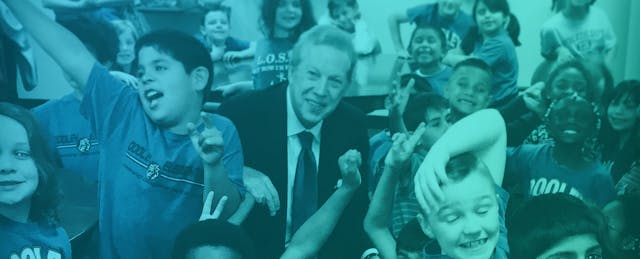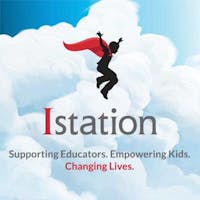Since his days as an elementary student in Texas, Richard Collins has loved history. He’s read about, pondered and strived to emulate remarkable Americans from Dwight D. Eisenhower to some of his own ancestors. Now as the Chairman and CEO of Istation, Collins is intent on sparking that same love of learning in new generations of students, while creating opportunities for them to succeed in school and, by extension, life.
After decades of business accomplishments in industries ranging from banking to oil and gas to media to real estate, Collins shifted his focus to education in 1984 when he launched the Today Foundation. The Texas-based nonprofit provides funds and offers leadership programs as well as anti- crime and drug abuse programs to low-income students throughout the state. But Collins wanted to do more. Specifically, he wanted to play a part in education reform.
So in 1998, he and seven colleagues launched an animated e-learning platform designed to engage elementary and middle school students in math, reading and Spanish curriculum while supporting teachers with assessment tools. Today almost 5 million students and educators around the world use Istation for teaching, learning and assessment.
EdSurge caught up with Collins to talk about education reform, personalized learning, and what the future holds for Istation.
EdSurge: Where does your passion for helping students come from?
Richard Collins: Your life experience impacts everything that you do. I had a lot of benefits in my life and I want to give back. What’s satisfying to me is making a difference in the world.
Our country has a lot of struggling students and they need a different tool than the textbook. I was talking to a preschool superintendent here in Texas. She said she had four-year-olds coming to her pre-K program that were at a two-year-old's development level.
Most kids—if you can't catch them up—may never catch up. We think we can help them catch them up.
Why is education reform important to you?
Through studying my family history I became interested in education reform issues including charter schools, scholarship programs, better pay and career ladders for teachers. My great grandfather was a state senator, on the Texas College Coordinating Board in the 1930s. My grandfather was a long-term trustee at Baylor University, a supporter of Baptist religious colleges, and supporter of historically black colleges back in the 30s and 40s and 50s.
Something I’ve realized is that a lot of education reform issues are politically sensitive. But in education, technology threatens no one. It is a teacher’s assistant and an administrator’s aid. It allows for individualized learning paths for all children and can evaluate what works and what doesn’t. It is a huge benefit.
So we started Istation with the goal of supporting teachers, students and the education system. We want to make sure all children who use our curriculum and assessments get the highest quality education that they can have.
How do you hope to impact education?
We're trying to personalize education—that's the future of effective education. We need to make the system fit the kid instead of the kid fitting the system. To do that you need to have personalization and innovation. Every child is different and they all learn different ways. Our role is to identify the way they learn and help them succeed using personalized data profiles, formative assessments and adaptive curriculum. Personalization makes education more interesting to a child. It helps engage all students–especially struggling students.
What are you most proud of?
I’m proud of the students we help. About five years ago, we got a call from a principal in Fort Worth. This principal was a former teacher—she had used Istation at her previous school. She'd been working with a child and a meeting was scheduled to determine whether this child should be put into special education. But the principal just knew it wasn’t the right path for that student.
They didn’t use Istation at her new school, but we figured out a way for this little boy to take our assessment and we were able to prove that in the right environment that student could absolutely thrive in a regular academic setting. We were able to make a difference in that child’s life—maybe even save him from being labelled for the rest of his life.
How does Istation support school administrators?
A lot of teachers worry when children come into their classroom really behind. They wonder, ‘How am I'm supposed to get them from worst to first in a year?’
But with Istation, administrators can use skill growth reports to show progress in skills tested by student, classroom, tier group, grade-level all the way to district or state. We can measure how the teacher is doing in a fair way because we'll know if the children are far behind. We'll be able to note that immediately and show growth through the year.
We did a study for the Garland School District on the state end-of-the-year test for English Language Arts, with data from 1,275 students in grades three to six; in September we were able to forecast with a 95 percent probability how each child was going to do in the April end-of-the-year test.
If you can do that, then you can say, “Well, this child has a problem with these skills,” and you can deal with that before the child takes the test. If you get that information in February for an April test, it's too late.
What’s next for Istation?
We're going to take our whole curriculum and personalize it even more than it is now. Make it more adaptive. If you're a student’s who’s progressing quickly, we can ask more difficult questions. If you're behind, we can ask less difficult questions to move the process along. Then we’ll personalize the content so questions are related to things that are interesting to that individual student. That's the future. That's three, four years down the line.

There’s a red cape in your logo. What’s the story there?
The logo of a student leaping through the air wearing a red cape represents struggling, at-risk students who feel afraid and overwhelmed but, with Istation’s help, banish those negative feelings and focus on learning.
I also thought we should design real capes for students to energize them, let them know we recognize they can be super learners. All children can be a superheroes and superstars in their educational progress—and superheroes wear capes.



